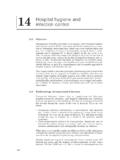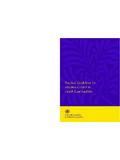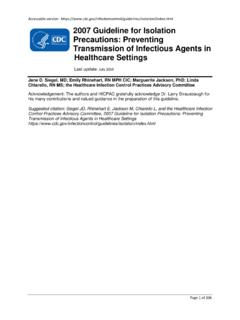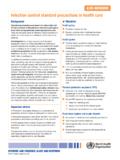Transcription of Precautions & Contraindications
1 - page 55 - 2010, Aquatic Resources Network. For reprints or publications: PH (800) 680-8624. Relax. Precautions & Contraindications Learning Objective: Recite general Precautions and Contraindications for patients who wish to work in the water. There are as many different lists of Precautions and Contraindications as there are therapy pools. The important point to remember is this: labeling a condition a precaution allows the therapist the discretion to treat or not treat the patient. Labeling a condition a contraindication , on the other hand, takes the discretion out of the aquatic therapy provider s hands. If a facility chooses to label some-thing a contraindication, they must make sure never to allow a person with that condition into their pool.
2 A contraindication means no exceptions . If your patient presents with any of the following conditions, disorders or infec-tions, you need to make a calculated decision about the relative potential for harm to the patient and to others with aquatic therapy. Possible Precautions or Contraindications : If your patient has A documented or anecdotal risk of aspiration; orders reading Thickened Liquids only or Nothing by Mouth ; an absent cough reflex An open access port to lungs (open stoma; on ventilator) A nasogastric (NG) or gastrostomy (G-) tube or a PEG A colostomy, urostomy, or ileostomy bag An area of open, macerated or non-intact skin, especially non or poorly heal-ing wounds A rash or skin condition (contact dermatitis, eczema, psoriasis); a chlorine or other halogen sensitivity Environmentally communicable condition (head lice.)
3 Athlete s foot) Incontinence of bladder or bowel, especially diarrhea An infectious respiratory disease (cold, flu, tuberculosis) An infection of the skin or nares especially an antibiotic-resistant infection (MRSA, VRSA) A stool-borne infection (Hepatitis A; E-Coli) Significant cardiovascular disease or respiratory compromise (low vital ca-pacity; low ejection fraction) A low T-cell count (or other sign of immunocompromise) Instability of ligament or capsule (ACL tear; history of shoulder dislocation) Poor thermoregulation skills (multiple sclerosis; children; pregnant women) Ventilation tubes for ears; prone to ear infections A seizure disorder Diabetes, especially insulin dependent DM Exercise induced chest pain (angina) Autonomic dysreflexia Orthostatic hypotension Active joint inflammation (rheumatoid arthritis, hemophilia) Or if your patient is: Significantly dehydrated Feverous, especially >101 Taking a diuretic Your Ideas - page 56 - 2010, Aquatic Resources Network.
4 For reprints or publications: PH (800) 680-8624. On dialysis On chemotherapy On post-surgical restrictions to motion ( no twisting of spine, no crossing legs over midline, no abduction of shoulder) Pregnant Very young (< 1 year old) Fearful of water (hydrophobia) Combative or difficult to control Sensitive to chlorine or other pool chemicals Mentally impaired to the point of the inability to be safe in water Culturally unable to be seen in immodest dress or to share pool facili-ties with the opposite sex. then you will need to be aware of any potential risks with immersion and exercise in water. Only you and your facility infection control and other management can decide which should become Precautions and which should be absolute Contraindications to aquatic therapy.
5 Let s examine the reasons behind these potential barriers to aquatic par-ticipations one at a time. A documented or anecdotal risk of aspiration; orders reading Thickened Liquids only or Nothing by Mouth ; an absent cough reflex Patients who are on aspiration Precautions , especially those with an absent cough reflex, are unable to keep liquid from entering their trachea or unable to expel liquid effectively before it enters the lungs. Certainly, patients with these restrictions should be limited from underwater activities. However, surface swim-ming and exercise may also present a high risk for both accidental and purpose-ful splashing and immersion. This risk is higher with children and individuals without the mental capacity to understand the risks involved in aspiration.
6 An open access port to lungs (open stoma; on ventilator) Individuals with tracheotomy stomas are at special risk during immersion in wa-ter. Because these patients do not have an anatomical barrier (closed mouth, closed glottis) preventing water from entering the trachea, there is a direct and open port to the respiratory tract. The risk of aspiration pneumonia becomes even greater in pools with poor water quality or inadequate disinfection. There are several commercially available products for individuals with trachs such as trach caps and even trach snorkels (for underwater swimming), but this remains one of the often cited Contraindications to aquatic therapy at many facilities. A nasogastric (NG-) or gastrostomy (G-) tube Nasogastric tubes (feeding tubes which travel through the nose to the stomach) are more an inconvenience than a true precaution for aquatic activities.
7 Prior to water sessions, most facilities separate the tubing from the feeding bag, cap the tub and tape the distal end on the face or neck of the patient. Because the tubing leads into the stomach and not the lungs, there is little risk involved even if the cap becomes loosened or separated. And NG tubes are relatively easy to reposition in the unlikely event that the tubing is pulled during aquatic sessions. G-tubes or gastrotomy tubes are commonly seen in children with feeding disor-ders. These buttons serve as a direct port for feeding into the stomach. Many physicians permit their patients with G-tubes to be immersed in clean water (private bathtubs, swimming pools, therapy pools) without special preparations. Other physicians ask patients with G-tubes to prepare for immersion by placing a water-impermeable dressing, such as Opsite or Tegaderm over the G-tube.
8 Typically all patients with G-tubes are told to avoid more suspect bodies of wa- Precautions & Contraindications Patients with open stomas need a compelling benefit to choose aquatics. - page 57 - 2010, Aquatic Resources Network. For reprints or publications: PH (800) 680-8624. ter; those with greater risk for contact with contaminants: ponds, lakes, and pub-lic hot-tubs. A colostomy, urostomy, or ileostomy bag Patients with any ostomy bag (bags which collect waste from the intestinal tract) present a special risk with immersion, especially if their bags do not seal properly or the skin around the bag is macerated. Because these bags collect waster, a punctured or leaky bag can result in fecal matter being deposited into the pool.
9 Equally troubling perhaps, is the potential for additional contaminants from poorly disinfected pool water from entering the system of a patient who is already at high risk due to the underlying medical condition which required the bag. Patients with long-standing and well-managed ostomies are not typically barred from swimming or therapy pools. One method of preparation for aquatic activities is for the patient to empty his collection bag, place a clean gauze dressing over the bag, place a bio-occlusive dressing (such as Tegaderm) over the entire bag, and then place a pair of compression or bikers shorts over the site. Some patients will take the additional step of wrapping a compression ban-dage like an Ace wrap around their abdomen prior to pulling on the shorts.
10 An area of open, macerated or non-intact skin, especially non- or poorly healing wounds Open wounds and macerated, unhealthy skin present a risk during immer-sion both to the public and to the patient. Any significant area of non-intact skin presents an open port for infection in poorly disinfected water. And immersion in water can further degrade the integrity of macerated, unhealthy skin, especially that present around wound beds or open otomies. Even immersion in properly disinfected water can cause addi-tional skin irritation in patients with chlorine or other halogen sensitivities. And while clean surgical wounds (such as those present after a knee sur-gery) present little risk to the public, persistent open sores or wounds can be colonized with infections such as MRSA which theoretically can be spread to others.







